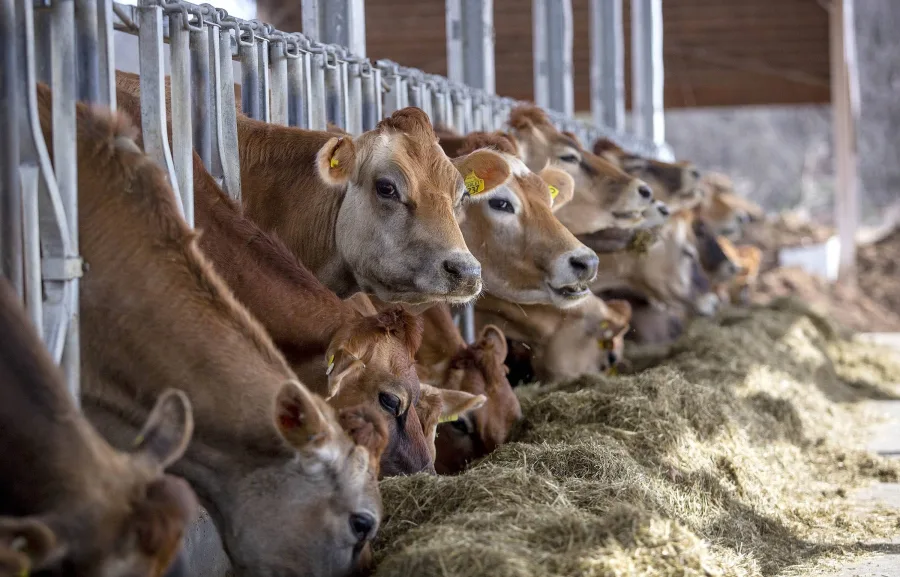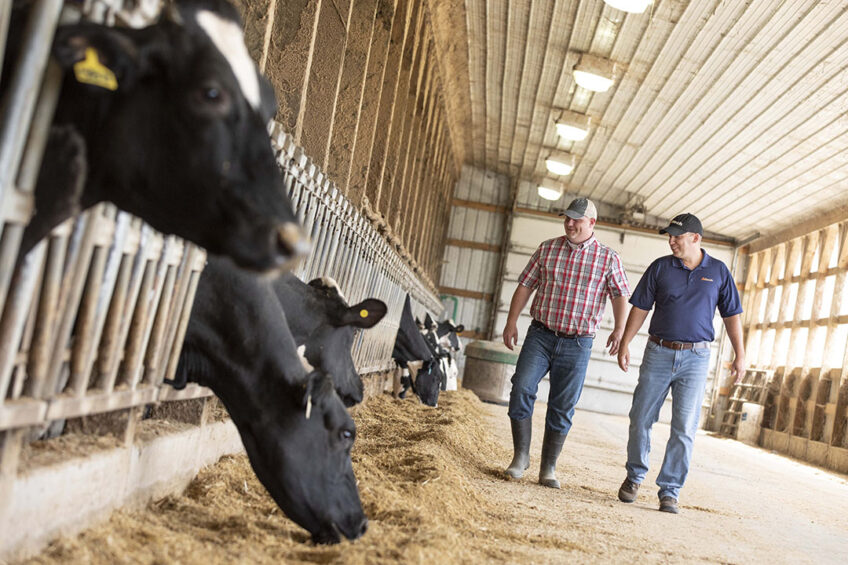Discover how to maximize efficiency and health in Jersey cattle. Learn about their unique nutritional needs and how to address them effectively.

Holsteins are known for high milk volume, while Jerseys shine for quality and adaptability. Their smaller size and unique traits make them valuable assets. However, they have distinct nutritional needs that require careful attention to optimize health and efficiency. Jerseys excel in producing nutrient-rich milk and are incredibly efficient in feed conversion and land use. Addressing their specific requirements can boost milk quality , which refers to the composition and characteristics of the milk, and herd health, making them essential for sustainable and profitable dairy farming.
Jersey Milk: Nutrient-rich, Flavorful, and Versatile for Health and Culinary Applications
When it comes to dairy, the nutritional quality of milk significantly impacts consumers. Jersey milk, boasting higher protein, milkfat, and calcium than Holstein milk, is a standout choice. Its increased protein levels aid muscle maintenance and repair, crucial for active and aging individuals. A higher milkfat percentage promotes the absorption of fat-soluble vitamins essential for overall health. Additionally, elevated calcium content strengthens bones and teeth, making Jersey milk ideal for boosting family nutrition. This superior quality of Jersey milk instills confidence in dairy professionals about the value they provide to consumers.
“The nutrient density of Jersey milk provides essential nutrients in higher quantities and enhances its culinary versatility. Chefs and home cooks prefer Jersey milk for its rich texture and flavor, which can elevate both sweet and savory dishes.”
- Improved Nutritional Profile: More protein for muscle health and milkfat for vitamin absorption.
- Culinary Excellence: Superior taste and texture favored by chefs.
- Enhanced Bone Health: Increased calcium supports strong bones.
Jersey milk’s unique nutritional composition also benefits beyond essential dairy consumption. Cheese, yogurts, and other dairy products made from Jersey milk often offer exceptional taste and quality, favored by consumers and chefs alike. This versatility and value highlight why Jersey Milk’s milk’s nutritional characteristics are indispensable.
Jerseys: Small Stature, Significant Advantages for Dairy Operations
Jerseys, with their smaller size than Holsteins, offer unique advantages to dairy operations. Their compact stature means they consume less feed and optimize barn space. Despite their smaller size, Jerseys excel in converting feed to milk with high protein, milkfat, and calcium levels. This unique trait empowers dairy farmers to maximize their resources and enhance their herd’s productivity.
Jerseys also maintain a higher dry matter intake (DMI) after calving, which is crucial for meeting energy needs during lactation and reducing metabolic disease risks. Their increased chewing improves rumen stability and fiber digestibility, making them more efficient feed converters than other breeds.
Scientific Validation: Jerseys’ Superior Feed Conversion Efficiency
Scientific research demonstrates that Jerseys are significantly more efficient than Holsteins at converting feed into milk components. Studies show that when producing the same amount of protein, milkfat, and other solids, Jerseys need 32% less water, use 11% less land, and consume 21% less fossil fuels. This efficiency highlights their minimal environmental impact.
Moreover, Jerseys extract and utilize energy from their diets more effectively, leading to higher nutrient levels in their milk. A glass of Jersey milk contains 18% more protein, 29% more milkfat, and 20% more calcium than Holstein milk. This nutrient density underscores Jersey milk’s superior quality and enhances the breed’s value in the dairy industry.
Key Nutritional and Health Differentiations: Feed Intake, Energy Metabolism, and Overall Health
When examining Jersey’s dietary and health needs, three areas stand out: feed intake and digestion, energy metabolism, and health.
Regarding feed intake and digestion, Jerseys maintain a higher DMI post-calving relative to their body weight. This, alongside spending more time chewing, supports a stable rumen environment, enhancing fiber digestibility and feed conversion efficiency.
In terms of energy metabolism, Jerseys extract more energy from their diet. Energy metabolism refers to the chemical reactions in the body that convert food into energy. Efficient energy metabolism is crucial for cow health and milk production, as it ensures that the cow’s energy needs are met. Jerseys’ ability to extract more energy from their diet means they require fewer resources than Holsteins, making them more environmentally sustainable. Their milk is richer in protein, milk fat, and calcium.
Regarding health, Jerseys’ smaller size and robust hooves reduce lameness and disease risks. Their higher rumen pH offers better resilience against acidosis. However, fewer vitamin D receptors in their gut increase their risk for milk fever, necessitating careful DCAD management.
Another critical difference is Jersey’s faster maturity rate, which increases their risk of becoming overweight. Effective strategies include housing them with older Holsteins to better match their nutritional needs and promote healthy growth.
Health Advantages: Why Jerseys Outshine Other Breeds in Dairy Farming
Jerseys boast substantial health benefits, enhancing their appeal to dairy farmers. Their tiny, hard black hooves produce fewer lameness issues, like hairy heel warts, common among larger breeds. This durability ensures Jerseys are productive, reducing mobility issues and associated treatment costs.
Additionally, Jerseys maintain a higher rumen pH, granting them better tolerance and quicker recovery from acidosis. This trait helps stabilize digestive health during stressful periods like calving, ensuring high feed efficiency and milk production without frequent digestive upsets.
However, Jerseys are more susceptible to milk fever due to fewer vitamin D receptors in the gut, making them three times more likely to experience this condition than Holsteins. Milk fever, also known as hypocalcemia, is a metabolic disorder that occurs when the cow’s blood calcium levels drop rapidly after calving. It can lead to muscle weakness, reduced feed intake, and even death if not managed properly.
Managing this requires proactive measures like monitoring dietary cation-anion difference (DCAD) and calcium mobilization strategies. Regular urine pH checks can help adjust prepartum rations. When current rations fall short, adding anionic salts can effectively prevent milk fever, safeguarding Jersey cow health and productivity.
Optimizing Health and Productivity through DCAD Monitoring and Glucose Enhancement in Jerseys
To manage Jerseys effectively, it is crucial to monitor and adjust the dietary cation-anion difference (DCAD) and enhance glucose production. These strategies will help mitigate the risks of milk fever while supporting overall energy balance and immune function.
- Jerseys maintain higher dry matter intake (DMI) post-calving, aiding in rumen health and feed efficiency.
- They are efficient feed converters, extracting more energy from smaller absolute feed intake.
- Jersey milk is nutritionally superior, with higher protein, milkfat, and calcium than Holstein milk.
- Jerseys mature faster, requiring careful feeding strategies to avoid overweight issues; housing with older Holsteins can help.
- Jerseys have healthier hooves and higher rumen pH, reducing lameness and acidosis risks.
- Monitor DCAD status closely to prevent milk fever, utilizing calcium mobilization strategies as needed.
- Enhancing glucose production can mitigate negative energy balance and support immune function.
- Breed-specific research is essential for optimizing Jerseys’ health and productivity.
First, consistently measure your cows’ urine pH, aiming for levels between 6.2 and 6.8. If current rations don’t achieve these levels, add anionic salts to the diet to improve calcium mobilization and prevent milk fever. Maintaining optimal DCAD is essential for Jersey’s health during its transition period.
Enhancing glucose production is vital to counteract the negative energy balance seen postpartum. Increase the energy density of rations by using highly digestible forages and grains, and consider glucose precursors like propylene glycol or glycerol. These can be administered postpartum to address the energy gap, supporting energy reserves and immune function.
Implementing these strategies requires careful observation and flexibility. Regular monitoring and timely dietary adjustments will help keep Jersey herds healthy and productive, meeting the demanding targets of modern dairy operations.
The Bottom Line
Jersey cattle have distinct nutritional needs that require special attention. Their efficient feed conversion, smaller size, and unique metabolism necessitate specific feeding and management practices to ensure optimal health and productivity. Addressing these requirements is crucial for the success and welfare of Jersey herds. By focusing on feed intake, energy metabolism, and health, farmers can maximize the potential of Jerseys, contributing to sustainable and profitable dairy farming.
Utilizing Jerseys’ superior feed efficiency and unique health benefits, dairy farmers can boost milk production and overall herd welfare. Jerseys’ higher milk solids and lower environmental impact enhance their value in sustainable farming. Their resilience to certain health issues and energy efficiency make them an optimal choice for modern dairy operations. Adapting management practices to meet the specific needs of Jersey cattle will lead to healthier, more productive herds.
I urge dairy farmers to integrate these tailored strategies into their operations. This will yield significant improvements in sustainability, productivity, and profitability. The future of dairy farming involves embracing the distinctive strengths of Jersey cattle, making them central to a thriving dairy industry.
Key Takeaways:
- Jerseys maintain a higher dry matter intake (DMI) post-calving, aiding in overall digestive efficiency.
- They spend more time chewing per unit of dry matter, promoting a stable rumen environment and increased fiber digestibility.
- For the same production of protein, milkfat, and other solids, Jerseys use significantly fewer resources compared to Holsteins.
- Jersey milk is richer in protein, milk fat, and calcium, enhancing its nutritional value.
- Housing Jerseys with slightly older Holsteins can mitigate the risk of excessive weight gain.
- Jerseys’ smaller stature and hard black hooves reduce susceptibility to lameness and certain diseases.
- Jerseys possess a naturally higher rumen pH, making them more resilient to acidosis.
- However, fewer vitamin D receptors make Jerseys more susceptible to milk fever.
- Monitoring dietary cation-anion difference (DCAD) and enhancing glucose production are crucial for optimal health and productivity.












